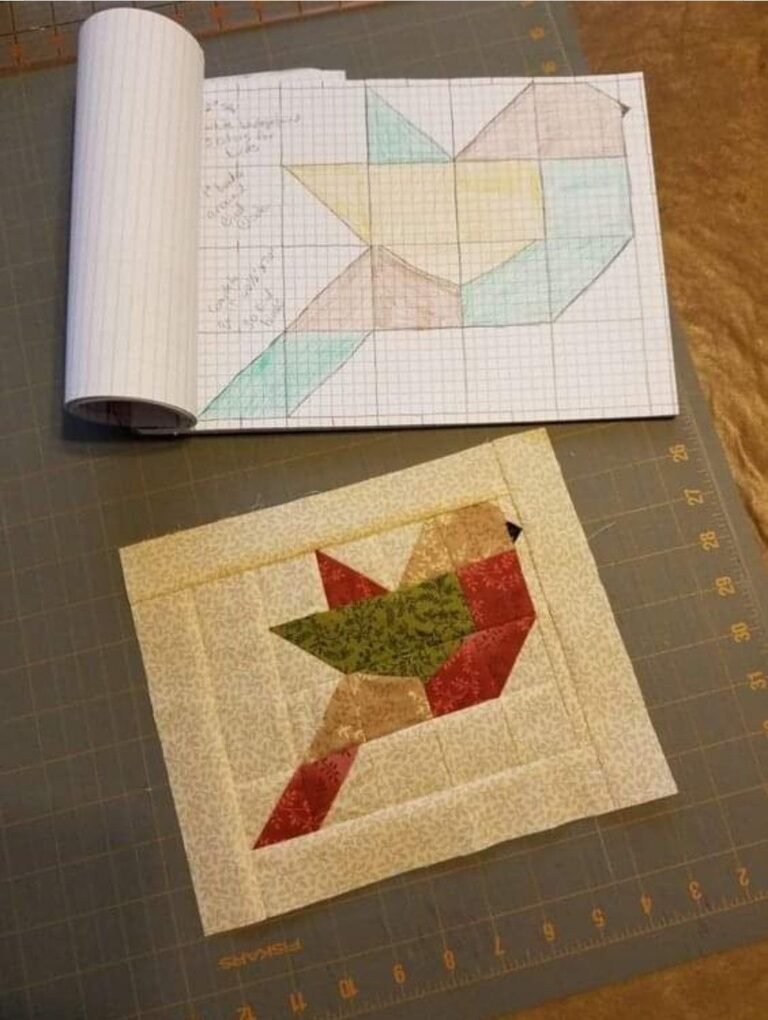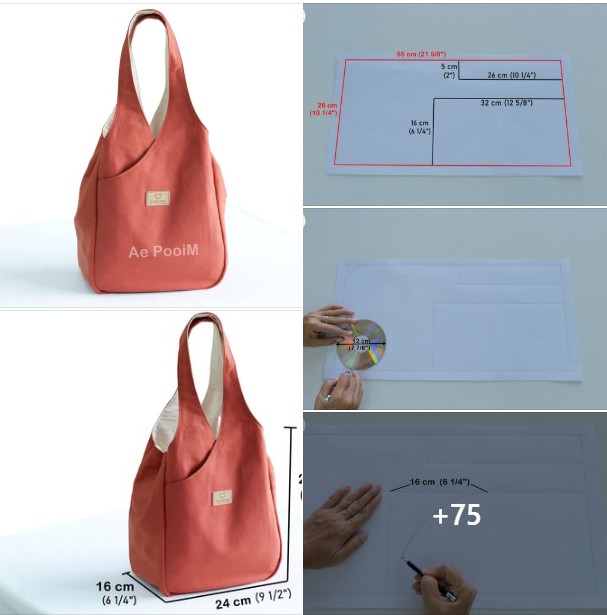
A cute fabric bag with three inner compartments is not only stylish but also incredibly practical. Unlike ordinary fabric totes, this design offers organization and functionality, allowing you to keep your belongings neatly separated.
Whether you plan to use it as an everyday handbag, a craft organizer, or even a travel pouch, learning how to sew this type of bag is a rewarding project that blends creativity with usability.
The popularity of a fabric bag with three inner compartments comes from its versatility. With dedicated sections inside, you can store makeup, stationery, or personal items without them getting mixed up.

It is particularly useful for people who like order and convenience. Beyond functionality, handmade fabric bags are eco-friendly, reusable, and can be personalized to match your style.
Making your own cute fabric bag is also a wonderful way to explore sewing as a craft. Even if you are a beginner, this project can be completed with simple techniques and basic materials. By following step-by-step instructions and choosing fabrics you love, you can create a unique accessory that is both beautiful and functional.
The first step to creating a cute fabric bag with three inner compartments is gathering your materials. Choosing quality supplies ensures your bag is durable and long-lasting. Cotton fabric is highly recommended for beginners because it is easy to handle, washable, and comes in countless patterns.
You will need outer fabric for the body of the bag, lining fabric for the interior, and a sturdier fabric such as canvas or interfacing to add structure. The interfacing is especially important because it prevents the bag from collapsing and gives it a polished look. Without it, your bag may appear flimsy.
For closures, you can choose between a zipper, magnetic snap, or even simple button loops depending on your sewing comfort level. A zipper provides maximum security, while a snap or button offers a softer, handmade charm. Handles or straps can be made from the same fabric, webbing, or even leather for extra durability.
Don’t forget sewing tools like scissors, measuring tape, sewing pins, and a sewing machine. While it’s possible to sew by hand, using a machine will give you cleaner, stronger stitches, which are important for a bag meant to hold daily essentials.
Thread selection also matters. Always choose thread that matches your fabric in both color and quality. Polyester thread is a reliable choice because it is strong and flexible. High-quality thread prevents unraveling, which extends the life of your bag.
Finally, prepare accessories like decorative buttons, tassels, or patches if you want to personalize your fabric bag. These finishing touches transform a practical design into something unique and stylish.
To make your fabric bag with three compartments, start by cutting your fabrics. You will need one set of panels for the outer bag, another set for the lining, and additional panels for the dividers. Make sure all pieces are cut evenly so the compartments align correctly when sewn.
Next, sew the divider panels. These will become the inner compartments of your bag. Place interfacing on the divider fabric to ensure they are sturdy enough to separate your belongings without sagging. Sew around the edges, leaving one side open, then turn the piece inside out to hide the seams.
Once your dividers are ready, attach them to the lining fabric. This step requires precision, as the compartments should be evenly spaced. Pin the dividers in place before sewing to avoid mistakes. Stitch carefully so the dividers stay secure and can withstand daily use.
After the compartments are attached, sew the lining pieces together, leaving an opening at the bottom for later turning. Do the same with the outer fabric panels, but this time make sure to add interfacing for strength. If you want a zipper closure, this is the stage to insert it between the lining and outer fabric.
Now it’s time to assemble the bag. Place the lining inside the outer fabric with right sides facing each other. Sew around the top edges, making sure the compartments remain aligned. Once stitched, turn the bag right side out through the opening left in the lining. Sew the opening closed neatly.
Finally, attach the handles or straps. Depending on your style, you can make short tote handles or longer crossbody straps. Reinforce the stitching where the straps connect to the bag, as this area carries the most weight. At this point, your cute fabric bag with three inner compartments is complete and ready to use.
One of the best parts of making a fabric bag with compartments is the opportunity to customize it. You can choose fabrics that reflect your personality or match different occasions. Bright floral prints make for a cheerful summer bag, while darker tones with metallic accents create an elegant evening accessory.
Another design idea is to mix fabrics for contrast. For example, pairing solid-colored fabric with patterned dividers makes the compartments more visible and stylish. This also helps you easily identify items inside your bag.
Embroidery is a wonderful way to personalize your fabric bag. Simple stitches can add initials, floral motifs, or even seasonal themes. Embroidery not only beautifies the bag but also adds a handmade touch that makes it truly unique.
If you want extra functionality, consider adding small outer pockets. These are perfect for items you need to access quickly, such as keys or a phone. Outer pockets can be zipped or left open for convenience.
Another creative option is decorating the bag with fabric appliqué. This technique involves stitching cut-out shapes onto the bag’s surface, such as stars, hearts, or animals. Appliqué allows endless creativity and can be used to tell a story through your design.
Finally, think about using eco-friendly fabrics. Recycled cotton, hemp, or upcycled materials not only make your bag sustainable but also give it a one-of-a-kind look. A handmade bag with a meaningful eco-conscious message can be both stylish and responsible.
After completing your cute fabric bag with three inner compartments, it’s important to care for it properly so it lasts for years. Regular cleaning is the first step. Most cotton bags can be machine washed on a gentle cycle, but if you’ve used delicate fabrics, spot cleaning may be safer.
Always check for loose threads and reinforce stitches when necessary. Since fabric bags are often used daily, the seams around the handles and compartments may weaken over time. Fixing these early prevents bigger damage later.
Storing the bag properly also extends its life. Avoid leaving it in direct sunlight for long periods, as fabrics may fade. Instead, keep it in a cool, dry place when not in use. If you have multiple handmade bags, rotate their use to reduce wear.
If you used interfacing or stiff fabrics, avoid folding the bag tightly. This may cause creases that are hard to remove. Instead, stuff the bag lightly with tissue paper when storing to help it keep its shape.
Adding a protective spray designed for fabrics is another useful tip. This makes the bag more resistant to stains and water, which is helpful if you carry it outdoors frequently. Just be sure to test the spray on a small area first.
Lastly, treat your fabric bag as a special item. Since it is handmade, it deserves care and attention. Not only will this keep the bag in good condition, but it will also preserve the effort and creativity you put into making it.
What makes a fabric bag with three inner compartments different from a regular tote?
It offers built-in organization by separating belongings into different sections, making it easier to find items quickly.
Do I need advanced sewing skills to make this bag?
Not at all. Beginners can complete this project with patience and by following step-by-step instructions.
What is the best fabric for a durable bag?
Cotton with interfacing or canvas works well. These fabrics are strong and easy to sew, making them perfect for beginners.
Can I add more than three compartments?
Yes. While three compartments are ideal for balance, you can adjust the design to include more sections if desired.
How can I make the bag stronger?
Use interfacing, reinforce seams, and choose durable fabrics. Double-stitching handles also adds strength.
Can I wash the bag in a machine?
If made from cotton, yes. However, delicate fabrics may require hand washing or spot cleaning.
Is this project suitable for kids?
Yes, older children can help with fabric cutting and decoration, but sewing should be supervised by adults.
Can I sell handmade fabric bags like this?
Absolutely. Handmade bags are popular at craft fairs and online shops because of their uniqueness and practicality.
Making a cute fabric bag with three inner compartments is a rewarding project that combines creativity, functionality, and personal style.
From choosing fabrics and sewing compartments to customizing with embroidery or appliqué, every step gives you a chance to design something unique. With the tips shared here, you can craft a bag that not only looks beautiful but also lasts for years.
Now that you’ve learned how to make this practical and stylish bag, I’d love to hear your thoughts. Share your opinions and suggestions—your feedback can inspire even more creative sewing projects in the future.
